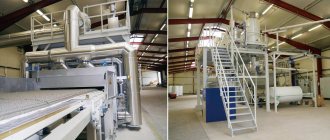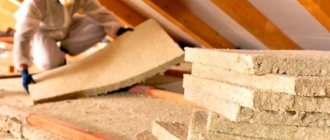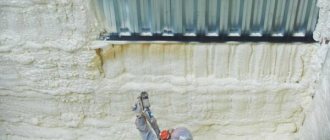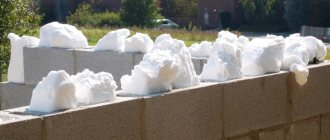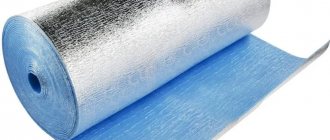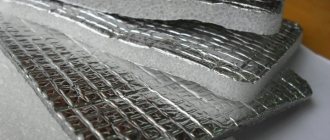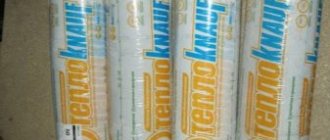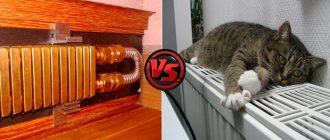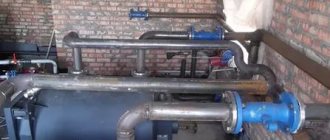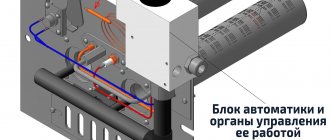Hello, dear readers!
How are you? Are you ready for the cold? Have you warmed up? Today I came across an article that, to put it mildly, puzzled me. It said that this winter would be very vigorous. That is, frosty and snowy. Well, what can we say? There are both advantages and disadvantages to this. The positive aspect is the fun entertainment - sleds, skates, skis, snowballs. And negative - heating the house will cost a pretty penny. In order not to be speechless when looking at the amount on the receipt, it is recommended to insulate the “nest”. Fortunately, there are plenty of materials for insulating a room.
I decided to look at what manufacturing organizations are offering today. My attention was drawn to the “old new” raw material – foam glass. Why "old new"? Well, how can I explain it to you? The old one is 86 years old, and the new one is improved. However, let's study the material in more detail. So, here’s a topic for you - foam glass: disadvantages, advantages, production, cost and much more. Shall we begin? Go!
Cellular glass: product features
A little history
Foam glass was invented by the honored worker of technology and science Isaac Ilyich Kitaygorodsky. The professor specialized in glass production technology, because he considered it the material of the future. The professor's invention was improved by US specialists in the 40s. Initially, foam glass was used as a floating material. But it soon became clear that it demonstrates excellent heat and sound insulation properties, is easily glued together, and is easy to process. Therefore, it was decided to use it in construction.
Thus, in Canada a building appeared, created from concrete slabs with a layer made of cellular glass. This event happened back in 1946. The experiment was very successful. The material has received well-deserved recognition. But, to the great regret of the inventor, it did not gain popularity in Soviet countries, since the cost was high and the production technology had not been developed. It was manufactured in the USSR, but the quality of the product left much to be desired, which led to the closure of factories.
But currently the production of this product is in full swing!
Concept
Balcony insulation
Foam glass is a heat-insulating material made from silicate glass and raw materials that promote gas formation. The insulation is often called foamed or cellular glass because it has a honeycomb-like structure. Due to this, it can boast of unique properties.
Production
Thermal insulation raw material - foam glass - is manufactured using powder technology. The process is quite simple, but labor intensive. It consists of the following steps:
- broken silicate glass is crushed;
- the crumbs are thoroughly mixed with gas-forming substances;
- the charge (homogeneous mass) is placed on a conveyor belt or in molds and sent to the oven;
- the glass softens, turning into a liquid but viscous mixture;
- under the influence of gases the gruel foams;
- the mixture cools slowly;
- the product is formed into blocks, slabs (sheets) or granules;
- the product is processed according to requirements;
- slabs, granules or blocks of foam glass are packaged.
We can say that ordinary glass, which is used in everyday life, and the cellular product are twins, since they are identical in composition, the only difference being the gas-filled pores of the foamed product.
Only high-quality materials and innovative equipment are used to produce blocks, granules or slabs. In addition, the products undergo control, which is carried out by experts in accordance with European quality standards.
Foam glass insulation
The unique set of properties of foam glass allows this material to be used quite widely: for insulating foundations, basements, floors, frame walls, roofs
[Click on photo to enlarge]
Foam glass is produced in the form of granules and slabs. Granules are a universal fill-in insulation material that has found wide application in insulating floors, walls, and roofs. Blocks are more often used for insulating facades, but can be used as insulation for walls and floors. You can also find broken foam glass on sale - crushed stone. It is cheaper than granules, but absorbs more water.
Insulation with foam glass granules
Granulated foam glass is used in the same way as expanded clay. It is poured between joists, into frame walls, or can be used as a filler for lightweight concrete. Foam glass easily fills all voids. Since it is completely environmentally friendly and safe for health, it does not need to be tightly insulated from the living space like glass wool.
When using granulated foam glass, you need to pour several fractions together - this will improve the thermal conductivity characteristics. If you fill the voids with quartz or perlite sand, the thermal conductivity of the entire insulation layer may suffer.
Kinds
Today there are two types of foam glass - granular and block.
In addition, there are three types of granular insulation:
- foam glass gravel;
- foam glass crushed stone;
- foam glass sand.
There are also three types of block insulation:
- slabs (foam glass sheets);
- blocks;
- shells (shaped foam glass).
If we compare the thermal properties of granulated and block glass, of course, gravel, crushed stone and sand are inferior to slabs, shells and blocks. But, nevertheless, granular insulation is more popular due to its relatively low price.
Foam glass wall insulation
In Russia, at least 5 million tons of glass are generated annually in municipal solid waste alone. Foam glass production is a method of converting cullet from landfills into a highly efficient, energy-saving material.
Production of granulated foam glass
Granulated foam glass is produced in the form of particles that have a close to spherical shape. Production is based on the foaming of individual, pre-rounded semi-finished granules in a rotating continuous kiln.
Production of slab foam glass
Slab foam glass is produced by foaming blanks in continuous tunnel furnaces. At the exit, the material is sent for long annealing and then to a sawing machine to give the slabs precise geometric dimensions.
Insulation of horizontal surfaces
Granulated foam glass easily fills any unevenness and can serve not only as a heat insulator, but also as a deflection
Insulation of vertical surfaces
Granulated foam glass fills any cavities and creates reliable thermal insulation protection.
Slab foam glass is an indispensable rigid, waterproof, durable thermal insulation material for roof insulation.
Thermal insulation of process equipment
All over the world, slab foam glass is used at facilities where compromise is unacceptable - nuclear power plants, submarines, factories, etc.
In Russia, at least 5 million tons of glass are generated annually in municipal solid waste alone. Foam glass production is a method of converting cullet from landfills into a highly efficient, energy-saving material.
Production of granulated foam glass
Granulated foam glass is produced in the form of particles that have a close to spherical shape. Production is based on the foaming of individual, pre-rounded semi-finished granules in a rotating continuous kiln.
Production of slab foam glass
Slab foam glass is produced by foaming blanks in continuous tunnel furnaces. At the exit, the material is sent for long annealing and then to a sawing machine to give the slabs precise geometric dimensions.
Insulation of horizontal surfaces
Granulated foam glass easily fills any unevenness and can serve not only as a heat insulator, but also as a deflection
Insulation of vertical surfaces
Granulated foam glass fills any cavities and creates reliable thermal insulation protection.
Slab foam glass is an indispensable rigid, waterproof, durable thermal insulation material for roof insulation.
Thermal insulation of process equipment
All over the world, slab foam glass is used at facilities where compromise is unacceptable - nuclear power plants, submarines, factories, etc.
Scope of application
Foam glass, due to its properties, is used for insulation:
- private houses;
- outbuildings;
- sports complexes;
- underground structures;
- industrial buildings;
- medical institutions;
- educational institutions;
- office facilities;
- recreational facilities - (for example, for baths, water parks, etc.).
The scope of application of the material is very wide, since the thermal insulation material is impeccable:
- to insulate the ceiling: the attic floor is filled with cement-sand mortar, and then the slabs are laid, after which a reinforcing screed is made;
- for walls: the surface is prepared, special glue is applied, the product is applied, pressed tightly and covered with plaster;
- for the floor: a layer of sand (3–5 cm) is poured, thermal insulation is laid or backfilled, joints are sealed, screed is applied, the covering is installed;
Yes, the material is popular due to its good technical characteristics.
Installation of foam glass slabs
The technology for installing foam glass is quite simple.
The slabs are glued with a special glue, and then the wall is lined with decorative material. For gluing blocks, a special two-part bitumen adhesive solution is used, which consists of a liquid and a dry component. The ingredients are mixed before use. For work outside the house, frost-resistant adhesives are used. Foam glass cannot be glued to a cement-sand mixture, because When dry, the solution shrinks and may crack.
It is best to attach blocks to wooden walls using special dowels. This method will ensure air exchange between the log house wall and the insulation, and will also not interfere with the movement of the tree during the period of residual shrinkage.
Surface preparation
- The base is cleaned of dirt and dust; when using glue, it is also very important to remove grease stains that will impair the adhesion of the materials. If there are pockets of mold and mildew, it is necessary to apply antifungal compounds.
- All metal elements must be coated with an anti-corrosion agent.
- The uneven surface must be leveled and then a primer mixture must be applied.
Fastening slabs to walls
- The back side of the insulation is coated with glue, it must be evenly distributed over the entire tile, and the solution is also applied to two side faces.
- In order for the slabs to lie flat, it is necessary to install a horizontal bar (wooden or metal) below at the level of the plinth.
- The slabs are laid in the direction from bottom to top. The first row is mounted on a support rail, which is removed after installation work is completed.
- The blocks of the second and subsequent rows are installed offset, so that the joining seams of the tiles of adjacent rows do not coincide.
- After the glue has dried, the tiles are additionally fixed with dowels.
When thermally insulating the walls of a log house, the slabs are laid in the same way, but without the use of glue.
Subsequent layers of the insulating cake depend on the type of decorative finish:
- If the wall is to be covered with decorative plaster, a reinforcing mesh is laid on top of the slabs;
- Before facing the wall with stone or other material that creates a large load, each tile must be additionally strengthened with 4-5 dowels, and a frame made of wooden slats or a metal profile must be installed on top.
- When constructing a brick wall, there must be an empty cavity at least 25mm wide between the insulation and the masonry.
- When finishing walls with clapboards, panels or siding, the frame method of fastening the sheathing is also used.
Floor insulation
Thermal insulation of the floor can be done with either tile or bulk insulation.
Insulation with foam glass blocks is performed as follows:
- Foam glass slabs are laid on top of the concrete base, they can also be laid directly on top of compacted sand.
- The next layer is waterproofing. To do this, you can use PVC film laid in two layers.
- The entire insulating structure is filled with cement screed. Any floor covering can be laid on top.
Stages of floor insulation along joists using granular filling:
- Wooden blocks are placed under the logs, on which boards are laid.
- The space between the ceilings is filled with foam glass granules.
- The top of the insulation is covered with a layer of vapor barrier.
- Lay the subfloor.
- Lay any floor covering.
Properties
Cellular glass is famous for the following properties:
- noise absorption – 56 dB;
- water absorption – 0–5%;
- vapor permeability – 0–0.005 mg/m*h*PA;
- thermal conductivity – 0.04–0.08 W/(m*K);
- humidity (sorption) – 0.2–0.5%;
- bending strength – 0.4–0.6 MPa;
- compressive strength – 0.7–4 MPa;
- effective operating temperature – -260 – +400°С;
- actual operating temperature – -260 – +230°С;
- deformation temperature – +450°С.
Based on this data, recognized advantages and annoying disadvantages can be determined.
Video description
Video about what foam glass is:
The main difference between granular material and blocks and sheets is its lower price. Thanks to this, granules are used more often.
Note! On the building materials market you can find a cheap analogue made on the basis of liquid glass. The material has a porous structure, and its composition is more related to adhesives. Naturally, its quality is in many ways inferior to the original. Its only comparative advantage is its 2-3 times lower cost.
Advantages
The material has many advantages. Let's look at the main ones.
- Safety. Does not contain substances harmful to the human body.
- Environmentally friendly. Made from environmentally friendly raw materials.
- Hygiene. Has antiseptic properties.
- Durability. Service life - more than 100 years.
- Versatility. It is used for insulation of any buildings.
- High adhesion. Combines with a lot of building materials.
- Biological passivity. He is not afraid of rodents, insects and microorganisms.
- Resistance to the negative effects of climatic factors. He is not afraid of temperature changes, precipitation, UV, etc.
- Resistance to mechanical factors. It does not deform and does not lose its properties, since it can withstand impacts and high loads.
- Unaffected by chemical factors. Does not react to acid.
- Resistance to thermal factors. Foam glass is an absolutely non-flammable insulation material.
- Ease of processing. It cuts perfectly with a regular hacksaw.
The material is worthwhile, but there are drawbacks and there are many of them, unfortunately.
roof insulation with foam glass
Insulation - Foam glass!
Unique modern insulation of a new generation!
Eco-friendly, safe, durable and lightweight! Designed for sound and heat insulation of any building structures (from private houses to skyscrapers and industrial enterprises). Unique insulation for a bath! Bathroom insulation with foam glass!
In Rus', houses and baths were insulated with natural materials. Today these components are also used, but working with them is long and painstaking. Any homogeneous thick wall does not guarantee effective heat retention - because it itself will absorb some of the energy. The process of insulating each bath is individual; has its own specifics due to inconsistent operation and special temperature conditions. The bathhouse premises must be provided with internal thermal insulation, which: will protect the wall materials from exposure to high temperatures; will maintain the temperature inside the bath; will allow you to quickly heat the bathhouse premises, avoiding unnecessary fuel consumption for warming up frozen walls.
One of the materials with a high thermal insulation rate is Foam glass.
The main advantage of this heat insulator is that it is laid along one continuous line, which creates an excellent seal that reduces heat loss to zero and prevents condensation from settling. The complete absence of organic components in the composition of foam glass eliminates the risk of weakening the thermal insulation characteristics of the insulation with regular exposure high humidity and temperature fluctuations. The material easily tolerates high temperatures. Foam glass is a lightweight porous material, the cell size ranges from a fraction of a millimeter to 1 cm. Foam glass is easily processed with carpentry tools.
Insulation made from foam glass has numerous operational advantages:
- fire safety
- ecological cleanliness
- no carcinogenic emissions when heated
- wide temperature range
- relatively light weight
- moisture resistance, no shrinkage
- resistance to rodents, fungi, microorganisms
- durability of operation
External insulation of the bath
Additionally reduce heat loss and protect walls from exposure
External insulation will help at low temperatures.
Three main technologies for performing external thermal insulation of buildings:
“Well” insulation is used for inter-wall thermal insulation of brick and frame-panel buildings.
A “wet” façade is a thermal protection method that uses sheets of heat-insulating material glued or attached to the surface of the walls and covered with façade cladding materials.
“Ventilated” facade - the insulation method is one of the most popular. Suffice it to say that traditional clapboard wall paneling is one of his examples.
The bathhouse is insulated from the outside by mechanically fixing the blocks end-to-end and in no case should the seams be filled with especially sand-cement mortars. It is through these seams (2 mm) that water vapor will escape without accumulating in the wood. You can hang siding on top of the blocks or plaster foam glass.
Internal insulation of a bathhouse (sauna)
Interior finishing includes heat, hydro and vapor barrier.
An important requirement for insulation materials is toxicity.
Polystyrene foam and all its derivatives begin to emit harmful substances at high temperatures; in addition, polystyrene foam burns well. Formaldehyde resins are used as a binder in classic mineral wool; their vapors are harmful to humans. Foam glass is not subject to temporary destruction, is environmentally safe, has high resistance to aggressive environments, is absolutely not afraid of moisture, the surface has high adhesion, at low density - high mechanical stability, and is not susceptible to the development of microorganisms. The fire-resistant characteristics of the material eliminate the risk of sudden fire or toxic smoke. There are no “cold bridges” at the joints of slabs over a wide temperature range. The material, universal in its characteristics, is suitable for insulating not only walls, but also ceilings and floors in a steam room, thereby creating a “capsule” effect.
“Pie” insulation technology
This technology has this name because of the several layers that make up the wall after the work is completed:
- 1 layer - load-bearing wall
- 2nd layer - insulation
- 3rd layer - sheathing
- 4th layer - cladding
Foam glass perfectly serves as a vapor barrier, so you save on a vapor barrier layer. The principle of fastening the blocks is the same - mechanical fixation. The seams, again, are not filled (under any circumstances!) with a binder. But, after facing the blocks on the inside, the seams must be sealed with hydro and vapor-tight sealants. Foam glass in a monolith does not allow steam to pass through; by sealing the seams, you create a hydro-vapor barrier structure that prevents water from entering the wood. The whole thing is plastered or tiled on top.
Insulation of the ceiling of a bathhouse (sauna)
The bath climate, especially in the steam room, is characterized by very high
temperatures in the upper part of the structure. The temperature in the bath can reach 120-160 ºС, especially in the local upper zones of the steam room (operating temperature of foam glass is from -260 to +430С). Since the installation is carried out along one continuous line, an excellent seal is formed, reducing heat loss to zero and preventing condensation from settling. All of the above characteristics of foam glass make it the most ideal insulation material for bathhouse (sauna) ceilings.
Bathroom (sauna) floor insulation
Foam glass does not absorb water, does not shrink, has a chemically resistant composition, does not swell or rot, which is especially important when insulating the floor in a bathhouse. In addition, the material can withstand mechanical loads and does not require a “warm floor” system. The thickness of foam glass slabs can be from 6 to 12 cm and the slabs are laid on both wooden and concrete floors.
Universal technical characteristics allow the use of foam glass for effective insulation of floors, load-bearing wall structures and ceilings. The durability of the material eliminates the need for additional financial costs during the operation of the bathhouse.
Flaws
Of course, every raw material has its negative aspects. Foam glass is no exception. Before purchasing material, you need to carefully study the negative aspects.
- High price. The production of raw materials requires innovative high-tech equipment, which leads to its rise in price. And also the production of foam glass requires high energy costs.
- Fragility. The raw material, despite its strength, is very fragile, which leads to cracking if installation recommendations are ignored.
- Lack of steam conductivity. Foam glass, as was said, is not subject to the destructive effects of biological factors, but the surface under it is easily damaged.
- Fear of alkalis and hydrofluoric acid. Cellular glass, like an aspen leaf, trembles at the “sight” of alkalis and hydrofluoric acid, since they are capable of destroying it.
- Heaviness. The raw materials are relatively heavy, which negatively affects the building structure.
- Durability. Of course, a long service life is a plus. But the materials used to construct the facility are unlikely to last more than 100 years. This means that the structure must be repaired periodically, and cellular glass is not intended to be reused. Which exit? Replacing insulation.
- Low impact strength. Cellular glass does not withstand even light impacts. Mechanical influence is the “death” of the material. Of course, if the insulation is in the structure, it is not afraid of impacts. He is afraid of them during transportation, unloading and installation.
- Impossibility of “reanimation”. If the glass is damaged, it can be taken to a landfill. It is impossible to glue or cover up the cracks.
Properties played a cruel joke on cellular glass, turning a huge number of advantages into disadvantages.
Thermal insulation of the house - we use “Geokar”
The most interesting stage of construction: the space between the double frame walls is filled with pressed peat briquettes “geocar”, they are laid with dressing, without mortar. The blocks are self-supporting and do not shrink over time. Since peat itself is an antiseptic, it does not harbor any living creatures, as well as fungi and mold.
The internal space of the frame is filled with Geocar insulation - pressed peat briquettes with the addition of sawdust. The blocks are self-supporting and are laid with dressing without mortar. When laying, you can do without vapor barrier membranes
Peat behaves very interestingly near the “dew point”. Condensation, which falls in others in the form of dew drops, freezes and destroys the material, but nothing like that happens in the thickness of peat. The steam condenses in the form of frost, which does not disturb the porous structure of the “geocar” and quickly evaporates—“sublimes,” as physicists say. Therefore, when laying thermal insulation from peat blocks, you can do without vapor barrier membranes, which are mandatory when building a frame house using mineral wool. This means that our house does not require artificial ventilation. This is another plus in favor of environmental friendliness and comfort.
Price
The cost of foam glass is steep. Prices, of course, vary, as they depend on many factors, but on average you can buy blocks by paying $120–400 per cubic meter. You can purchase slabs and shells by paying $110–350, and you can get a granular version by spending $35–100 per cubic meter.
What can we say? Insulation with foam glass is a very dubious and costly undertaking, since the material has a lot of serious drawbacks, and, in addition, is incredibly expensive. But, as they say, the master is the master. Maybe it’s not for nothing that they call it the raw material of the future. To buy or not to buy? That is the question! The choice is yours, dear readers.
Warmth and comfort to your home, dear friends! See you on other blog pages!
Wisdom quote: Reading is the best teaching (A.S. Pushkin).
House frame
Author's development of the creative team "EcoDomProject". The system is a double frame connected by rigid connections without cold bridges. Insulation is laid between the internal and external frame posts. Due to the high rigidity of the joints, the frame does not “lead” during the drying process, so wood with natural moisture was used during construction.
Double volume frame
They also used double beams. They, like the frame posts, are not subject to warping.
Construction of a house frame. The double frame of the house avoids many cold bridges, unlike a conventional frame
The design of the house allows for a free layout of the first and second floors, placing bathrooms, a kitchen or a toilet anywhere.
The peculiarity of the double frame is that no scaffolding is required during construction. The need for them may arise only at the stage of exterior finishing
Decorating the facade of the house
The customer chose to cover his house with a block house, but it can be made of any material: stone, brick, tiles or siding. Interior decoration - wood paneling, plasterboard, panels, decorative wall coverings, tiles, wallpaper, painting.
A house lined with a block house is very difficult to distinguish from a log house from afar
Decorative plaster will also be an option: for exterior finishing - with high vapor permeability, but at the same time high moisture resistance, and for interior work - denser, with a lower vapor permeability. This will avoid the accumulation of excess moisture in the thickness of the “geocar” and not use membranes.
How to choose insulation for a frame house? And is it necessary to carry out thermal insulation work? After all, the materials used for the construction of frame houses provide a high level of thermal insulation?
Sandwich panels, despite their undoubted advantages, have thermal insulation characteristics that are only suitable for regions with mild climates. Such panels are thin and do not provide a sealed structure. In harsh winters, only the right choice of insulation for a frame house can solve this problem.
Porous polymer materials
Technologies for using foam plastics in residential construction are widespread. Extruded and foamed polystyrenes are especially often used.
Most of the expanded polystyrene is produced on import lines from foreign raw materials. The most active manufacturers are domestic enterprises with the lines BASF and Knauf (Germany), Neste (Finland).
However, a significant disadvantage of expanded polystyrene is the lack of fire resistance: at temperatures above 80°C it melts, turning into highly toxic flammable gases and liquids.
Foams are dispersed polymer systems. This means that in the structure of the foam, the polymer itself and the gaseous medium are mutually distributed in space, which, regardless of the initial composition, is inevitably replaced by air over time. Figure 3.2 shows a photograph of a typical structure of expanded polystyrene foam (left photograph). It is clearly visible that the air cells are separated by thin films of polymer material. Obviously, due to the insignificant thickness of the films, a significant proportion of the polymer material is always available for the gas phase. But it is especially interesting to see what happens to polystyrene foam even after slight artificial aging. To do this, the material was kept in a thermostat at 60°C for only 10 hours (right photo). It is clearly visible that many films have turned into an openwork mesh-web. Naturally, such a change is irreversible and does not improve the thermal insulation properties of the material. That is, even with such an insignificant and short-term thermal effect, the polymer foam changed its structure, and a process of destruction began, which will only intensify over time.
| Fig.3.2. Photos of the structure of expanded polystyrene: fresh and artificially aged |
In addition, foam plastics are not only organic compounds, but also have a very high surface contact area with atmospheric oxygen. If an organic compound is exposed to air, it will inevitably be oxidized by oxygen. Since foam plastics have the maximum possible surface, they will oxidize at the maximum speed compared to similar, but monolithic - massive - polymers. Therefore, for any foam plastic, it is inevitable to assume a finite and limited operating time, when its operational properties are still within acceptable limits. Naturally, with increasing temperature the rate of oxidation will only increase. Therefore, all foam plastics are fire hazardous materials. And finally, if foam plastics oxidize even at room temperatures, then the products of such oxidation have a negative impact on the environment. Based on the foregoing, all foam plastics inevitably have three negative performance properties: fragility, fire hazard and environmental unsafety.
.
Using practical examples of foam plastics from specific manufacturers, it is shown that the durability of enclosing structures using foam plastics varies from 13 to 43 years.
Therefore, the process of aging and destruction of polymers is inevitable and irreversible due to the fact that it is based on natural processes, primarily oxidation. Naturally, in this case, the products of such destruction should be released into the environment, and such “environment” will be residential premises.
From a theoretical point of view, issues of environmental hazard of foam plastics directly follow from the possibility of their oxidative destruction, which is facilitated by the high specific surface area of foams and the release of various products, mainly of an organic type, during this process.
A number of monographs are devoted to the hygiene and toxicology of polymeric materials in general and foam plastics in particular. All authors discuss the composition and quantity of released products, but the very fact of obligatory gas evolution from polymeric materials is not questioned at all.
In practice, the need for careful environmental control is reflected in the Guidelines for sanitary and hygienic control of polymer materials intended for use in the construction of residential and public buildings (Ministry of Health of the USSR, regulatory document No. 2158-80, March 28, 1980), where a list of substances subject to mandatory determination during sanitary-chemical studies of the main types of polymer building materials, including foam plastics. Unfortunately, at present, the need for such control is usually ignored, although the results of sanitary supervision over the introduction of polymer materials show that many chemical compounds, even in minimal quantities, cause effects of varying duration and nature (genetic, toxic, allergenic, embryotoxic, immunosuppressive, etc.). ).
There are already first results in judicial recognition of houses as not meeting sanitary and technical standards due to the use of environmentally hazardous thermal insulation materials in construction. So back in 1995, warrants for apartments in Novokuznetsk at the address of Mira were declared invalid.
One of the main reasons for the release of toxic components from expanded polystyrene is the oxidative destruction of organic compounds on the surface of the polymer foam. Naturally, in full accordance with the laws of chemistry, the rate of oxidation with increasing temperature increases not just quickly, but exponentially. Therefore, always at a certain temperature, any organic compound, including polymers, will begin to oxidize spontaneously, or, simply put, to burn. When advertising foam plastics, manufacturers, when describing this property, are somewhat disingenuous, claiming that any foam plastic does not burn or goes out on its own. The fact of this behavior of polystyrene foam does not indicate the fire safety of this material. The fact is that the official classification of all building materials for fire hazard is carried out according to a standard methodology, which takes into account the loss of mass of the material when heated in air, and not at all the ability to burn independently after removing the source of flame. A detailed description of the methodology is described in the relevant GOST. Let us note the following phrase from this document: “Building materials are classified as non-combustible with the following values of flammability parameters: - the temperature increase in the furnace is no more than 50°C; — weight loss of the sample is not more than 50%; — duration of stable flame combustion is no more than 10 seconds.
Construction materials that do not satisfy at least one of the specified parameter values are classified as flammable.” Moreover, the temperature in the furnace during testing should reach 745-755°C (clause 6.4.3 of the specified GOST). So far, no organic compounds have been invented that could withstand such temperatures in air. Therefore, according to the fire hazard classification, all foam plastics belong to class “G”, that is, combustible materials.
Research by the Russian Research Center for Fire Safety VNIIPO of the Ministry of Internal Affairs of the Russian Federation, presented on the website www.aab.ru/sertif
clearly indicate the high fire hazard of polymer materials. For example, the following fire test report on polystyrene foam indicates that the toxicity value of the samples is close to the limit value of the class of highly hazardous materials.
If we summarize the problems that arise when using foam plastics as thermal insulation materials in construction, they can be reduced to a limited service life, uncertainty regarding environmental safety and a high fire hazard
in the event of an emergency.
Based on this, the solution to create a heat-insulating material from an inorganic material seemed quite logical. Such a material must also have a high specific surface area to involve the maximum amount of air in its structure, but at the same time it must be based on a material that does not interact with atmospheric oxygen. Naturally, such material is the majority of natural inorganic compounds, predominantly of a silicate nature. Technologically, when working with silicate melts, the simplest way to create a high specific surface area is to obtain thin filaments. Historically, mineral fiber materials have been the most widely researched and marketed thermal insulation materials.
Warm roof
The rafter is quite ordinary. But the roofing material is special and was made to order. Galvanized steel plates cover the roof like “scales”.
Compressed straw slabs
The roof is well insulated with lightweight basalt-based fiber insulation. By the way, the developers recommend using a cheaper, but no less effective material, “pressol” (it is based on pressed straw).
More massive load-bearing panels made of straw
The roof has a significant slope of 52°, this is done so that it can be used as a heat collector (in the future it is planned to install solar panels). In principle, such a house can be heated using solar energy almost all year round, with the exception of the two coldest months.
Specifications
All insulation materials are characterized by their individual parameters, including foam glass; the disadvantages and advantages of each material are taken into account when choosing. The cells of foam glass are filled with air; this material also has a second name - gas glass.
Foam glass can withstand both very high (200-400 degrees) and low temperatures without deformation; it is resistant to mechanical stress and moisture penetration. Therefore, the material is widely used for other construction projects.
Warming properties are characterized by the following parameters:
- density (the material is available with density values of 200, 300 and 400 kg/m 3);
- brands of different densities correspond to thermal conductivity characteristics of 0.09, 0.12 and 0.14.
The denser the material, the easier it conducts heat. Accordingly, the brand of foam glass with a minimum density has the best thermal insulation properties.
Expanded polystyrene
Expanded polystyrene is the name of a whole group of materials. This includes expanded polystyrene foam (foam plastic), as well as extruded polystyrene. Both are produced on the basis of polystyrene. Only in the first case is it foamed, and in the second the material is obtained by extrusion from an extruder.
Extruded polystyrene foam is used infrequently for insulating the walls of frame houses, since it does not have high enough adhesion to adhesives, and the surface of the panels is smooth without the need for additional processing to install this heat-insulating material. Most often, sheets of plywood are installed on top of the panels, and a special composition is used for fastening - adhesive foam.
Expanded polystyrene foam is used more often. But it needs additional waterproofing, especially when it comes to insulating the basement or foundation, since prolonged contact with moisture destroys it.
